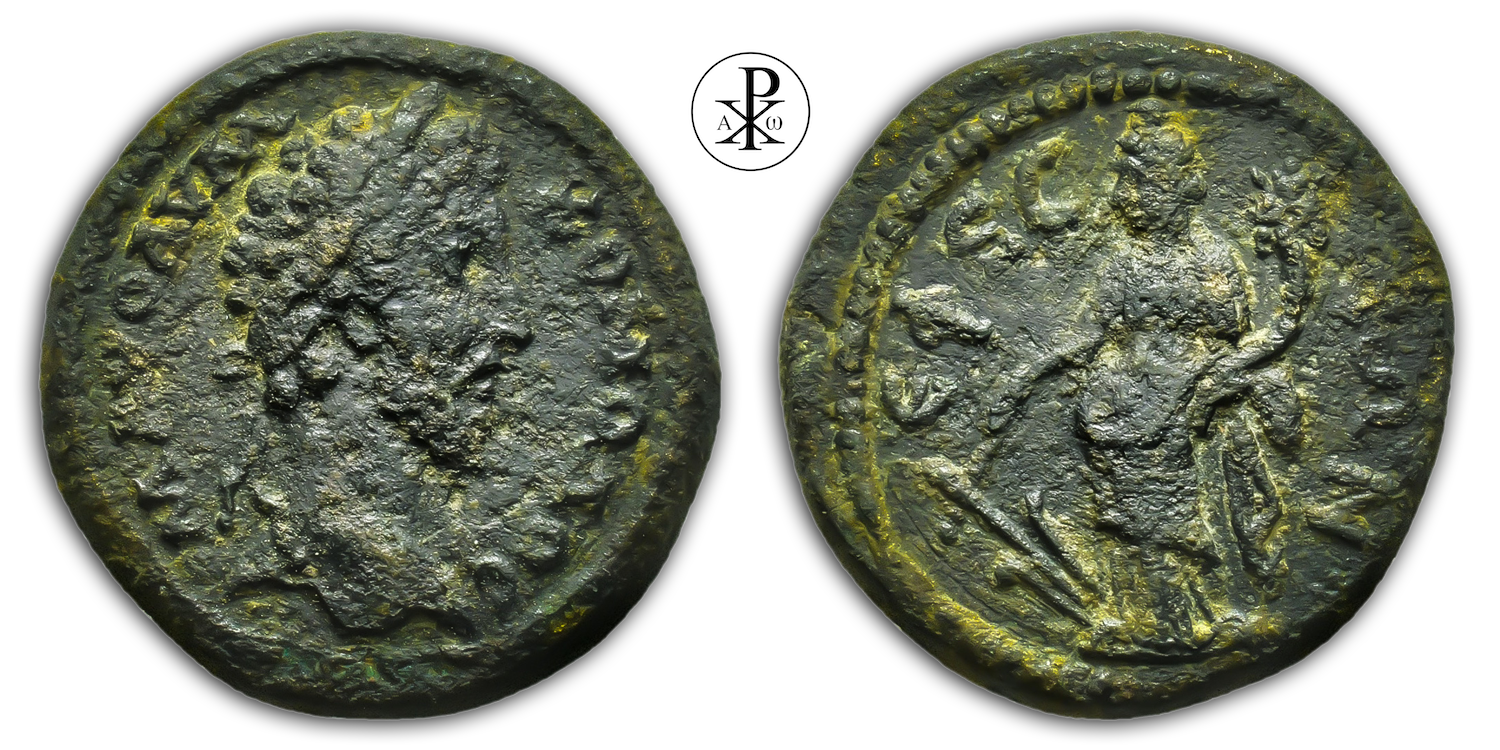Imperator Caesar Marcus Aurelius Commodus Antoninus Augustus
Reign: Commodus
Mint: Ephesus, Ionia
Date: 182/184 AD
Nominal: Bronze
Material: AE
Diameter: 28mm
Weight: 8.80g
Reference: RPC IV.2 11494 (this coin)
RPC Online: https://rpc.ashmus.ox.ac.uk/coins/4/11494
Rare: Specimens 3 (0 in the core collections)
Provenance: N&N Numismatics London, Great Britain (Auction 15, Lot 244)
Pedigree: –
Special: RPC Online Plate coin
Obverse: Laureate head of Commodus, right
Inscription: Μ ΑV ΟΛVΜ ΚΟΜΟΔΟϹ
Translation: Marcos Aurelios Olympios Komodos
Translation: Marcus Aurelius [Godfather Zeus] Olympius Commodus
Reverse: Tyche standing left, wearing kalathos, holding rudder and cornucopia
Inscription: ƐΦƐϹΙΩΝ
Translation: Ephesion
Translation: City of Ephesus
Comment: In ancient times, Ephesus, located in Ionia, was one of the oldest, largest and most important cities in Asia Minor and was home to the Temple of Artemis (Artemision), one of the Seven Wonders of the World. In ancient times, the city was located directly on the sea; due to sedimentation as well as climatic and seismic changes, the coastline shifted westwards over time, so that today the remains of the city are located several kilometres inland. The ruins of Ephesus today lie near Selçuk, about 70 km south of Izmir on Turkey’s west coast (Aegean Sea). The Turkish name of the present excavation site is Efes. The first decades of Roman suzerainty over the polis of Ephesus were marked by growing tensions, which ultimately escalated in the bloodbath of the Vespers of Ephesus, when the Greek citizens of the city killed numerous Romans and Italians in 88 BC. Things calmed down in the imperial period and Roman rule was henceforth perceived as less oppressive. Ephesus was one of the important and, with perhaps over 200,000 inhabitants, also one of the large cities of the Roman Empire, as well as the seat of the governor (proconsul) of the province of Asia. Numerous public buildings were built, financed both by the city and by wealthy citizens. These included a market basilica in honour of Augustus and temples to the emperors Vespasian and Hadrian, who were worshipped as part of the imperial cult. The Parthian monument to Lucius Verus (now in Vienna), erected around 170 AD, is remarkable. In 262 AD, Ephesus was hit by a severe earthquake, and shortly afterwards Gothic warriors sacked the place.
An interesting feature of the bronze coinage from Ephesus presented here is the titulature of Commodus on the obverse, which, among other things, honours and equates him with the god-father Zeus Olympios. The identification of Zeus and the reigning emperor can be grasped for the first time in Ephesus under Domitian, but later became quite common under his successors. The city fathers of Ephesus succeeded in winning over the emperor Domitian for a temple of the imperial cult (Neokoros). M. Lämmer also sees the foundation of the Ephesian Olympia in connection with the Domitian neocoria. It has not yet been conclusively clarified in what way the eponymous god Zeus Olympios had already played a leading role in the cultic life of the city. Either way, the triad, consisting of the Ephesian Agon (sporting and musical competition), the emperor’s cult and the emperor’s identification with Zeus Olympios, gained massive importance in the city. Under Hadrian, the cult and the games probably reached their peak. On the occasion of his second visit in the summer of AD 124, celebrations were set up in Ephesus as a pentaeteric agon – the so-called “Hadrianeia”. Also worth mentioning is the so-called Hadrian’s Temple on Kureten Street – one of the most famous monuments of ancient Ephesus. The excavator Franz Miltner interpreted the building – supposedly in accordance with the building inscription – as the Neocorian Temple of Ephesus, the official imperial cult temple for Hadrian, whose construction had been permitted to the city by the emperor himself. The merging of the emperor and Zeus Olympios into Hadrian Olympios took place increasingly from 128 AD onwards, as is shown above all by inscriptions and coins. Presumably with the news in the winter of 128/9 AD, when the news arrived in Ephesus that Hadrian had inaugurated the cella of the Athenian Olympeion and assumed the title Hadrianos Olympios, the idea of expanding the name of Hadrianeia to “Hadriana Olympia” may have matured among the Ephesians.
The reign of Commodus, who took on the title of Olympian again for the first time after Hadrian (as can also be seen on the coin presented here), was again reflected in an expansion of the name to “Hadrianeia Komodeia”. In contrast to the probably only temporary designation of Artemiseia as “Artemiseia Komodeia”, the designation “Hadrianeia Komodeia” seems to have lasted longer – attested by an inscription from 229 AD. Even if one assumes that the two victories recorded there at the Hadrianeia Komodeia must be dated to an early age of the sprinter – perhaps they took place in the boy or youth class – they would still probably fall into the period after the reign of Commodus. In the case of the Hadrianeia, it seems to have played a role that the later emperor Septimius Severus declared Commodus to be his ancestor, which also explains the longer existence of the designation “Hadrianeia Kommodeia”. The name changes and extensions to “Artemiseia Komodeia” and “Hadrianeia Komodeia” are interesting and revealing in that they show that the person of the emperor and his cult could not only find their way into existing cults and agons of established gods, but also into those of other emperors. However, the integration of the emperor Commodus into the name of the agon was not associated with any privileges that we know of. It was probably more an act of gratitude towards the emperor, perhaps due to concrete measures for the city. In any case, two statue bases, which testify to the re-erection of emperor statues after his damnatio memoriae and subsequent rehabilitation, speak for a great attachment of the Ephesians to Commodus.
